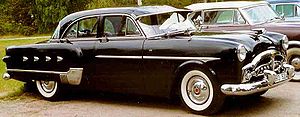These comments are from the Wikipedia article on the Google search
First generation (1955–1956)
For 1955, the Fairlane name replaced the Crestline as Ford's premier full-size offering. Six different body styles were offered, including the Crown Victoria Skyliner with a tinted, transparent plastic roof, the regular Crown Victoria coupe with lots of stainless steel trim, a convertible Sunliner, the Victoria coupe, and traditional sedans. All featured the trademark stainless-steel "Fairlane stripe" on the side. Power options were a 223 CID (3.7 L) straight-6 engine and a 272 CID (4.5 L) V8. The 292 Y-Block was offered as an option and was called the Thunderbird V-8.
Few changes were made for 1956; a four-door Victoria hardtop and two new, more powerful V8 options, of 292 CID (4.8 L) and 312 CID (5.1 L), the latter available up to 225 brake horsepower (168 kW), were introduced. The Lifeguard safety package was introduced.
Second generation (1957–1959)
Second generation (1957–1959)
For 1957, a new style gave a longer, wider, lower and sleeker look with low tailfins. A new top trim level was reversed, the Fairlane 500. For the first time, the lower-level Custom line had a shorter wheelbase than the Fairlane. Engines were largely the same as the year before. The big news for 1957 was the introduction of the Fairlane 500 Skyliner power retractable hardtop, whose solid top hinged and folded down into the trunk space at the touch of a button. Unfortunately, it attracted more attention than sales; the option was expensive, somewhat unreliable, and took up almost all the trunk space when retracted. Even so, it required the roof to be made shorter than the other Fairlanes, and the trunk to be larger. The reason for this was simply that this car was designed, from the ground up, as a Lincoln Continental. Projected losses resulted in a last minute marketing decision to restyle the vehicle, from the bottom of the windows down, as a member of the Fairlane family.
Another facelift for 1958 saw fashionable quad headlights, a grille that matched the 1958 Thunderbird, and other styling changes. New big-block FE V8s of 332 and 352 CID (5.4 L and5.8 L) replaced the previous largest V8s, and a better three-speed automatic transmission was also available.
A new top-level full-size model was introduced at mid-year 1959, the Ford Galaxie.
A Fairlane is featured in the 1965 James Bond film Thunderball, and also briefly in the 2002 Bond film Die Another Day.









